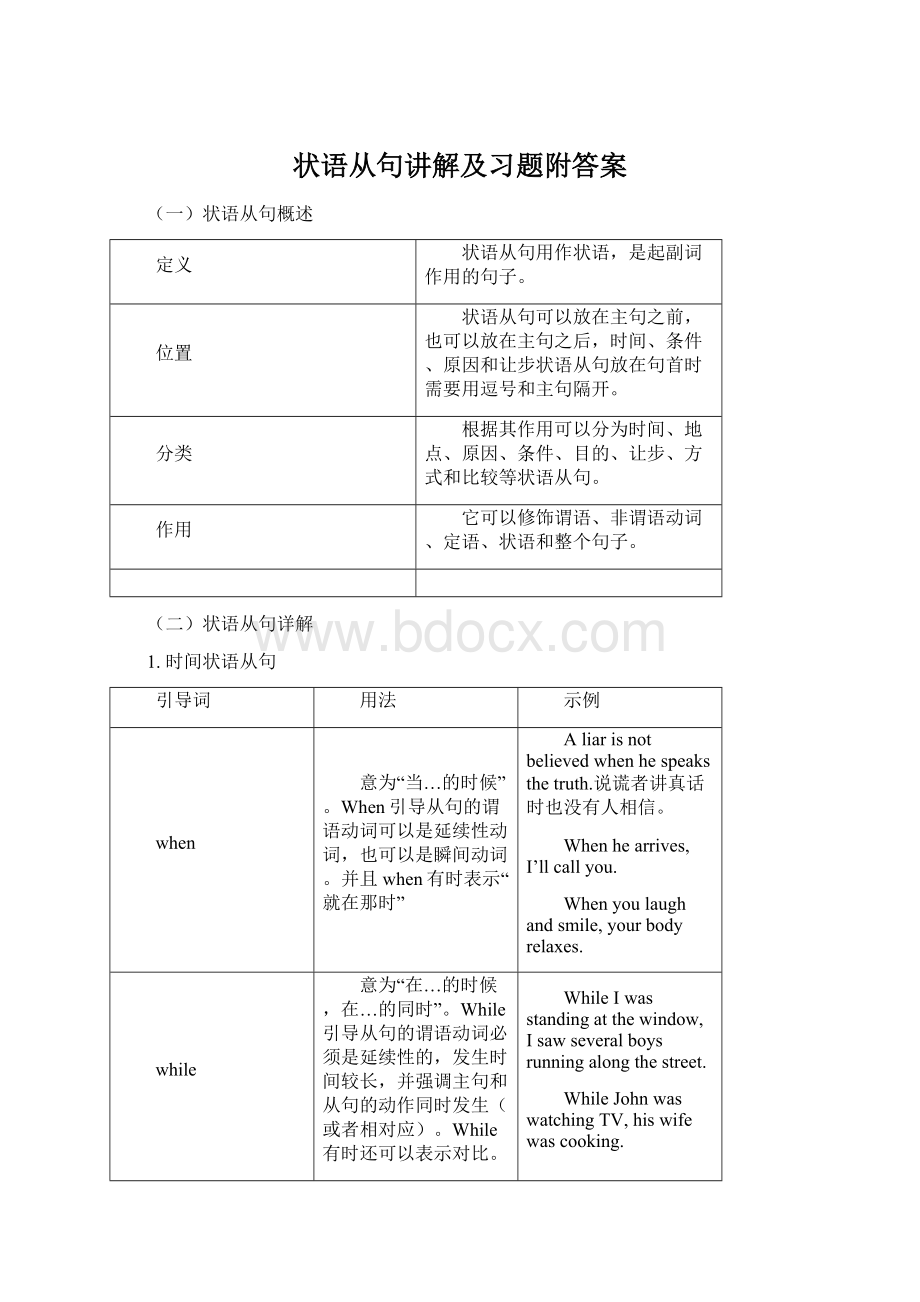状语从句讲解及习题附答案.docx
《状语从句讲解及习题附答案.docx》由会员分享,可在线阅读,更多相关《状语从句讲解及习题附答案.docx(14页珍藏版)》请在冰豆网上搜索。

状语从句讲解及习题附答案
(一)状语从句概述
定义
状语从句用作状语,是起副词作用的句子。
位置
状语从句可以放在主句之前,也可以放在主句之后,时间、条件、原因和让步状语从句放在句首时需要用逗号和主句隔开。
分类
根据其作用可以分为时间、地点、原因、条件、目的、让步、方式和比较等状语从句。
作用
它可以修饰谓语、非谓语动词、定语、状语和整个句子。
(二)状语从句详解
1.时间状语从句
引导词
用法
示例
when
意为“当…的时候”。
When引导从句的谓语动词可以是延续性动词,也可以是瞬间动词。
并且when有时表示“就在那时”
Aliarisnotbelievedwhenhespeaksthetruth.说谎者讲真话时也没有人相信。
Whenhearrives,I’llcallyou.
Whenyoulaughandsmile,yourbodyrelaxes.
while
意为“在…的时候,在…的同时”。
While引导从句的谓语动词必须是延续性的,发生时间较长,并强调主句和从句的动作同时发生(或者相对应)。
While有时还可以表示对比。
WhileIwasstandingatthewindow,Isawseveralboysrunningalongthestreet.
WhileJohnwaswatchingTV,hiswifewascooking.
as
意为“一边…一边…”。
As引导的动作是延续性的,发生时间较短,一般用于主句和从句动作同时发生;as也可以强调一前一后。
ThewriterwasangryashewastravellingonatraintoLondonbecausesomeonehadinvadedhis“space”.
Hesmiledashestoodup.
after
意为“在…之后”。
表示主句动作发生在从句动作之后。
主句与从句的动作时间关系与before引导的从句相反。
Withmanyhungryvisitorswaiting,don’tstaytoolongatyourtableafteryouhavefinished.
Ifanearlyexitisnecessary,youcanleaveafterasceneisover.
before
意为“在…之前”。
引导的从句不用否定形式的谓语,并且当before引导的从句位于主句之后,有时译成“就,才”。
当主句用将来时,从句总是用现在时;如果before引导的从句谓语用的是过去时,则主句动词多用过去完成时,这样以便体现动作的先后。
Youcan’twatchTVbeforeyoufinishyourhomework.
Beforeitended,thetheatrewasalmostempty.
MyfatherhadleftforCanadajustbeforetheletterarrived.
till
意为“直到”。
一般情况下可以和until互换。
如果主句中的谓语动词是瞬时动词时,必须用否定形式;如果主句中的谓语动词是延续性动词时,用肯定和否定形式都可以,但表达的意思不同。
Shedidn’tevenknowthatitwasanearthquaketillshesawashaking(movingfromsidetoside)light.
Thefiremanworkedveryhardtillthefirewasout.
until
意为“直到”。
在强调句型中多用until。
如果主句中的谓语动词是瞬时动词时,必须用否定形式;如果主句中的谓语动词是延续性动词时,用肯定和否定形式都可以,但表达的意思不同。
I’mwaitingformysister.Iwon’tgotoseemyuncleuntilshecomes.
WaituntilIfinishwhatIamdoing.
since
意为“自从,从…以来”。
引导从句的谓语动词可以是延续性的动词,也可以是瞬时动词。
一般情况下,从句谓语动词用一般过去时,而主句的谓语动词用现在完成时。
但在Itis+时间+since从句的句型中,主句多用一般现在时。
IhavebeenstudyinghardsinceIenteredthehighschool.
ItisfouryearssincemysisterlivedinBeijing.
ItisfiveyearsmonthssinceourbosswasnotinBeijing.
assoonas
意为“一…就…”。
引导时间状语从句时,如果主句用了将来时,从句一般使用现在时。
Tomwillcallmeassoonashegetshome.
IwillcallyouassoonasIarrive.
2.地点状语从句
引导词
用法
示例
where
意为“哪里”。
“where引导的地点状语从句,(there+)主句”“哪里…哪里就…”。
主句在从句后面时,there可用可不用;主句在从句的前面时,一般都不用there.
Wherethereisawill,thereisaway.
Theyweregoodpersons.Wheretheywent,theretheywerewarmlywelcomed.
Youshouldhaveputthebookwhereyoufoundit.
wherever
意为“无论何地”。
anywhere/wherever引导地点状语从句+主句。
anywhere本身是个副词,但是常可以引导从句,相当于连词,意思相当于wherever,anywhere引导的从句可位于主句之前,也可以位于主句之后。
而wherever本身就是个连词,表示“在何处,无论何处”。
Wherevertheseais,youwillfindseaman.
I’llgoanywhereyougo.
3.条件状语从句
引导词
用法
示例
if
连词,意为“假如,如果”。
当主句是将来时的时候,从句要用一般现在时。
Don’ttalkloudlyatthemeeting.Ifyoudo,youwillhavetoleave.
We’llgoforapicnicifitdoesn’trainthisweekend.
unless
连词,意为“除非(=ifnot)。
当主句是将来时的时候,从句要用一般现在时。
Don’tdiscusstheproblemswithyourpartnerunlessyouareaskedtodoso.
Iwon’tgothereunlessyoucomewithme.
4.原因状语从句
引导词
用法
示例
as
意为“因为”。
引导原因状语从句时表示附带。
说明“双方已知的原因”,语气比since弱,较为正式,位置较为灵活(常放于主句之前)。
Astheweatheriscold,Istayathome.
Asitisraining,you’dbettertakeataxi.
Asyouaretired,you’dbetterrest.
since
意为“因为”。
引导的原因状语从句一般放于主句之前表示已知的、显然的理由(通常被翻译成“既然”),较为正式,语气比because弱。
Sincetheearthlookslikeaball,thesuncanshineononlyhalfofitatatime.
SincetheraceisinApril,Ihadtorunthroughoutthewinter,andinBoston,wintersarecold.
Sinceeverybodyishere.Let'sbeginourmeeting.
because
意为“因为”。
引导的原因状语从句一般放于主句之后,表述直接原因,语气较强,最适合why引导的疑问句。
Because引导的原因状语从句有时可以与becauseof短语互换。
Thewomanpreferswinterbecauseshecanskate.
I’dliketocollectstampsbecausetheyareinteresting.
I’mverytiredthesedaysbecauseofstudyingphysics.
Hecan’tcomebecauseheisill.=Hecan’tcomebecauseofhisillness.
for
意为“因为”。
引导的原因状语从句并不说明主句行为发生的直接原因,只提供一些辅助性的补充说明,for引导的原因状语从句只能放于主句之后,并且必须用逗号将其与主句隔开。
Hemustbeill,forheisabsenttoday.
Hecouldnothaveseenme,forIwasnotthere.
5.目的状语从句
引导词
用法
示例
sothat
意为“以至,以便”。
目的状语的谓语常含有may,might,can,could,should,would等情态动词。
Trytospeakloudenoughsothatpeoplecanhearyouclearly.
Mr.Greenspeaksveryloudlysothatallthepeoplecanhearhimclearly.
inorderthat
意为“为了”,相当于sothat.inorderto后面可以跟动词原形构成目的状语,不是目的状语从句。
Weshallletyouknowthedetailssooninorderthatyoucan/maymakeaarrangements.
6.结果状语从句
引导词
用法
示例
so…that
意为“如此…以至于…”。
so+adj./adv.原级+that,so是副词,只能修饰形容词和副词。
so还可与表示数量的形容词many,few,much,little(这四个形容词表示多或少时)连用,形成固定搭配。
so+many或few+复数可数名词+that;so+much或little+不可数名词+that.
ThisyearithasrainedsoheavilyinSouthChinathatlotsofproblemsarecaused.
Theiceonthelakewassothinthatpeoplecouldn’tskateonit.
Toooften,wespendsomuchtimethinkinga